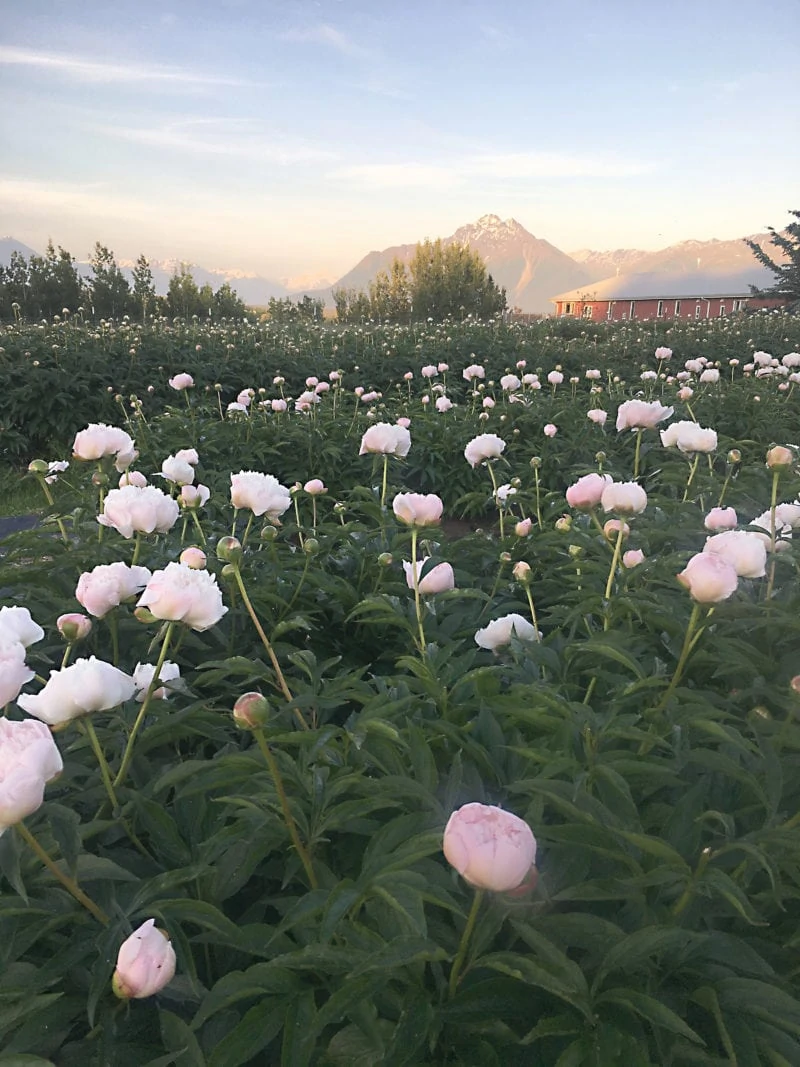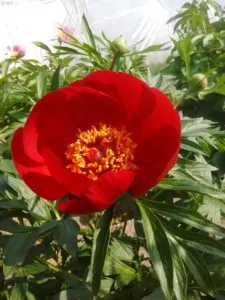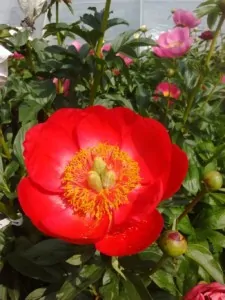Peonies for fanciers and growers all over the world.
Translated from an article first published in a Dutch trade journal: Neefjes, H. “Pioenen voor liefhebbers en telers over de hele wereld.” In: Vakblad voor de Bloemisterij, nr 12, June 13, 2023.

A part of the wide assortment of Peony Shop Holland. These are the hybrids. The Scholten brothers are also active in the hybridization and propagation of lactifloras.
“Our standard 3-5 eyes root divisions are so large that a horticultural crate is filled with only 25 of them instead of the usual 50”, Joshua Scholten from Peony Shop Holland says. With sophisticated fertilization and crop care on fertile sabulous clay in West-Friesland (a province in The Netherlands) this has proven possible over the last years. Hybridizing and selecting make their offer even more interesting.
Joshua Scholten points to one of the many peonies which are blooming on their fields. “That’s White Vanguard. A double white which we received some 20 years ago from an American hybridizer. It has large flowers and blooms one to two weeks earlier than Red Charm, which is usually harvested as one of the first peonies here in The Netherlands. That earliness of White Vanguard is an important characteristic, because cut flower growers want to be in the market as early as possible and spread their harvest over a period as long as possible. On top of that there’s demand for whites, although pink is the most requested color in peonies. But in the latter color we also have more than enough choice.”
Looking out over the fields of several acres in the polder close to the West-Friesland village Zwaagdijk we do indeed notice a lot of pinks and whites, in many shades, but also yellows, reds and purples. “Sometimes people ask if we also have blue peonies. Not yet, is my answer then.”
White Vanguard wasn’t the first peony Scholten found at the other side of the Atlantic Ocean. As a student he already browsed the internet in the mid-90s for exclusive peonies. Computers were a hobby and at home they were already growing peonies. “Hybridizing peonies is a hobby for several people in the United States. Those peony hybridizers posted images of their results online, which I saw, and I’ve tried to buy the most interesting ones. In 1995 we imported our first bare root plants.”
Several contacts from those early years are still there, a result from mutual respect and honest trade, says Scholten, who never travelled to the USA in all those years. “The hybridizers there must want to give them to you. Of course we pay for their novelties, but I also see it as a gift because there are more interested people in the world knocking at their door.”
A quick glance at the online offering of Peony Shop Holland, the company Joshua runs with his brother Jeremy, shows that White Vanguard is only available again in 2027. Joshua: “He’s popular and thanks to its’ unique qualities also a good foundation for our own hybridizing program. He improves our assortment. The many descendants we now have are not 100% like their parents, just as with people, but some qualities are there.”
We walk towards Maximus. A double white with flowers so large that Scholten once laid a cabbage next to it to take a picture. “In 2016 we registered our first peony cultivars, this is one of those six. In 2022 we registered 222 cultivars. We use names that refer to the Roman era. It makes our assortment immediately recognizable in the market. Some cultivars receive a special name, as is the case with this pale pink one, having flowers that resemble a rose. We named it after our mother Tini Keeman, she loved roses.”
Customers are all over the world: a wide audience from gardeners and collectors of special flowers to professional cut flower growers. A cut flower grower usually caps prices at some 10 euros. Fanciers pay a multiple of this for exclusive cultivars: € 1,000 for a bare root is no exception. “We use six price scales based on availability and distinctiveness. For truly exclusive varieties we also charge royalties. The bulk comes from our own bare roots, but we also buy some from colleagues that aim for the upper end of the market, thus healthy, large roots which are virus-free and true-to-name. An exclusive variety means we usually have only 20 to 100 roots available in any given year.”
The webshop was made under own management, as are apps to register some 40 different cultivar characteristics and keep records of hybridizing programs, as well as online invoicing. “It’s all digitized,” Scholten says as he shows on his smartphone a list of cultivars planted on the plot we’re standing at. It’s also easy to follow with the naked eye as they are planted alphabetically and for each cultivar an aluminium plate with the cultivar name is pinned into the soil. During the season the grower can easily add remarks for each cultivar when checking and selecting his fields. A snowflake icon for example shows that a given cultivar is frost prone. Or a current image can be added to show some abnormality.
Hybridizing work is in full swing. Around his waist Scholten carries an apron containing plastic containers filled with pollen. The flowers which have been hand-pollinated are marked with a label saying who the father is of the seeds to be harvested later on.
Sowing and growing the seeds is being done in a barn greenhouse. It takes some 3 to 4 years to see the first flower of a seedling. Still a small plant, the selection process of ornamental value, the most important characteristic, can finally start then. The following years other traits come into play: bud presentation, bud and plant health, number of stems, earliness and others. “After some 10 years there’s enough information. The plants have grown to maturity by then. Another 10 years later there are some 1,000 to 3,000 plants of a cultivar. Sometimes bare root divisions have already been sold in the meantime, usually between October 1st and December 1st. Growth and sales differ for each variety.
Company profile
Company: Peony Shop Holland in Lutjebroek
Owners: Jeremy (51) and Joshua (43) Scholten
Activities: Hybridization, propagation and bare root sales of peonies. Uses some 8 hectares (20 acres) of land for this and some 700 m2 barn greenhouse for growth and judging seedlings.
Website: https://www.peonyshop.com/
Company history
1964: Jan Scholten joins the horticultural company which was started by great-grandfather Simon Scholten in 1875.
1964-1989: Growing of flowerbulbs (tulips and irises) and outdoor vegetables. Forcing of tulips was started in the 80’s, as was the cut flower growing of peonies. Grandfather Jan is still in the company.
1989-1999: Theo continues the company with his wife Tini Keeman and son Jeremy in 1989 by the name Scholten-Keeman. Their son Joshua joins in 1995. Flower bulb growing ends in 1999.
1999-2006: Joshua buys exclusive peony varieties through the internet. Peony propagation and hybridization is started. Peony Shop Holland is started in 2001 for the sale of bare roots.
2006-2023: Only peonies are left. Cut flower growing ends in 2016. Focus on exclusive varieties in hybridization, propagation and trade. Mother Tini died in 2005 and Father Theo in 2011.























